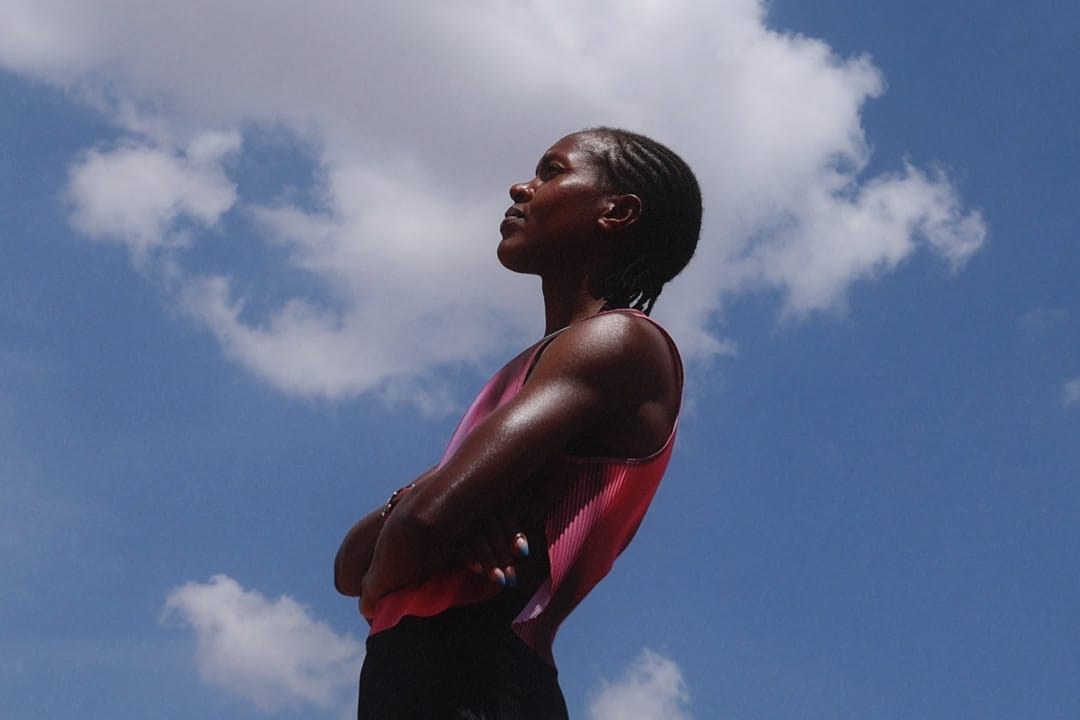
Hello! Welcome back to The Footprint – and happy Friday.
Best of luck to everyone running the Brooklyn Half tomorrow, and the Hackney Half and Great Manchester Run on Sunday.
📬 Edition #15: As Faith Kipyegon bids to become the first woman to run a mile in under four minutes, Olympian Shalaya Kipp explains why it matters… And Jenn Jones, a long-time spectator of the London Marathon, on running it for the first time.
Was this email forwarded to you? Sign up here.
Dreaming Bigger

(Courtesy of Nike)
You’ve probably heard of one running milestone in May 1954: the month Roger Bannister, on a track in Oxford, England, became the first man to run a mile in under four minutes.
But 23 days later came another significant breakthrough. May 1954 was also the month Diane Leather, at Birmingham’s Alexander Stadium, became the first woman to break five minutes in the mile.
Seven decades later, four academics posited a question in a study published earlier this year in the Royal Society Open Science journal. Could a female athlete run a mile in under four minutes?
The world record has fallen, again and again, over the years. The current holder, three-time Olympic gold medalist Faith Kipyegon, ran 4:07.64 in July 2023.
With a pacing formation that improved aerodynamic drafting – one pacer in front and another behind, rotating in two fresh pacers at 800 meters – the academics concluded Kipyegon could, indeed, break four minutes. “Hopefully,” they wrote, “Ms Kipyegon can test our prediction on the track.”
Next month, she’ll do just that.
Nike, Kipyegon’s sponsor, has announced Breaking4: an audacious bid by the world’s fastest female miler to break four minutes, on June 26 at the Stade Charléty in Paris.
Elliott Hill, the sportswear giant’s CEO, has promised it will do “everything in our power” to help, “combining cutting-edge sport science with revolutionary footwear and apparel innovation” to make it happen.
It has form here: Breaking2, the high-profile Nike project to help a man run a marathon in under two hours, culminated in Eliud Kipchoge becoming the first (and currently only) athlete to do so, in 2019.
There are plenty who say Kipyegon won’t succeed. “Spoiler alert,” Robert Johnson, co-founder of LetsRun wrote last month. “She’s not going to break 4:00. And it’s not going to be particularly close.”
And while Nike has not confirmed either way, few expect the attempt will be record-eligible. Key decisions on pacing and footwear to shave seconds off her time may veer from global standards, just as they did for Kipchoge.
Does that matter?
Shalaya Kipp, who represented the US in the 3,000m steeplechase at the London 2012 Olympics, is now a postdoctoral research fellow at the Mayo Clinic in Rochester, Minnesota – and one of the co-authors of the paper which generated such a buzz earlier this year.
“Did it matter with Breaking2? Not really,” she told The Footprint. “It was still an extraordinary demonstration of what’s physiologically possible.
“Even if Kipyegon runs, say, 4:03, that would be a monumental achievement and a major milestone for women’s athletics. Whether or not it’s record-eligible, it’s still pushing the boundaries – and that has immense value.”
Beyond time and place, most of the details of this attempt remain under wraps. Nike has said it is focused on “footwear, apparel, aerodynamics, physiology and mind science,” but its announcement omitted specifics.
When Kipyegon last broke the mile world record in Monaco in 2023, she was potentially aided by the conditions, Kipp noted. “Warmer or more humid air reduces aerodynamic drag, which can offer a small advantage,” she said. “However, those same conditions also increase the body’s thermoregulatory stress, which can impair performance.
“Similarly, racing at altitude would lower air resistance, but the reduced oxygen availability would have a far more detrimental effect on aerobic capacity.”
Paris in late June “seems like a reasonable compromise,” said Kipp. “Sea level, moderate climate, and a fast track.”
The ultimate pacing formation, and Kipyegon’s feet, will be closely scrutinized. For Breaking2, in 2017, Kipchoge wore the Nike ZoomX Vaporfly 4%, the shoes which helped trigger the game-changing and controversial boom in “super shoes” across the sport.
“One area that’s frequently overlooked is the sports bra,” added Kipp. “For elite runners with exceptionally high ventilation rates, unrestricted expansion of the chest cavity is critical.”
Should Kipyegon fall short next month, she’ll be in good company. On his first attempt to break two hours in the marathon, Kipchoge missed the mark by 26 seconds. Only two years later, at a different exhibition event in Vienna, did he make it.
Some still question the point. “I’d rather this sort of thing never happened,” sports scientist Ross Tucker told Front Office Sports earlier this month. “I think it’s gimmicky, and invites some sketchy practice.”
Kipp takes a different view. Beyond Kipyegon’s central goal of running faster than any woman has run before, she says this project could have a vast impact.
“The mile is such an iconic event, especially for younger athletes,” she said. “So many high schoolers and collegiate runners race the mile – it’s a benchmark. Seeing someone like Kipyegon chase a sub-4 barrier will be incredibly inspiring, especially for young women in the sport.
“Regardless of the outcome, this attempt will elevate visibility, spark conversation, and encourage the next generation to dream bigger.”

(Courtesy of Nike)
AROUND AND ABOUT
⏱️ The Forgotten Lesson from Bannister’s 4-Minute Mile Quest | Steve Magness
🏅 They Competed In The Olympics And Won Marathons. Now They Run With The Rest Of Us | Caitlin Carlson for Women’s Health
👟 The Rapid Rise of ‘Illegal’ Running Shoes | Rachel Bachman for the Wall Street Journal
🛍️ This Runner Used His Wife’s London Marathon Medal to Collect $285 Worth of Freebies | Brian Metzler for Runners World
‘Never Again’

(Courtesy of Jenn Jones)
By her count Jenn Jones has stood on the sidelines of the London Marathon no fewer than 14 times, cheering friends, relatives and complete strangers as they confronted the course.
Even after moving out of the city, she continued to turn up on race day each year – come rain or shine – and support everyone and anyone that ran past.
Two years ago, on a drizzly Sunday morning in the UK capital, I was nervously trudging around the early stages of the course when I heard someone shout my full name. I looked up and saw Jones, wearing a bright yellow anorak and holding a matching sign. “You can still win this,” it read.
“The marathon is everything I love about humanity: resilience; tenacity; a dollop of humour,” she said. “Inspirational humans giving their all for good causes.”
She has no memory of entering the ballot, but last month somehow found herself on the other side of the fence. It was London’s turn to cheer her.
“The marathon means so much to me,” said Jones, “so to be on the other side of it was really surreal and wonderful. I love having random interactions with people I don’t know in everyday life, and what I realised afterwards was during the marathon I’d had about 1,000 tiny interactions all in one go – people cheering my name, giving about 100 high fives to spectating kids, telling people how much I was enjoying their signs… I think that’s why I loved it so much! And I was so full of gratitude.”
Race day wasn’t without its setbacks, of course. After pulling together “the world’s best” motivational playlist, Jones lost an earbud on the way to the start line.
But before long she was off, making her way around the course she had helped so many others around over the years. She crossed Tower Bridge at halfway, having dreamt about it for months, and spotted friends in Canary Wharf, as she approached the final stages.
And then she reached Buckingham Palace. “When I saw the finish line I just started laughing and screaming at the photographers on the edge of the course, ‘there it is, THERE IT IS!’,” she said. “I knew it was coming, of course, but I couldn’t believe I had made it!”
So what now? Preparing for last month’s race, Jones was very much looking forward to returning to the sidelines.
“As I was training I said: never again. As I was running it I said: never again,” she said. “As soon as I crossed the finish line I was desperate to do it again!”
Jones was among the 1.1 million people who entered the ballot for next year’s London Marathon. No matter the outcome, she’ll be there.
RECENT EDITIONS
#14 Space On The Mountaintop | industry leader Frankie Ruiz on sustaining the running boom
#13 You Can’t Be What You Can’t See | 26.TRUE race directors on rewriting the marathon
#12 London Calling | ultra athlete Ali Young’s record breaking bid
Thanks for reading! Let me know what you think: just hit ‘reply,’ or email me.
Have a great weekend.
– Callum